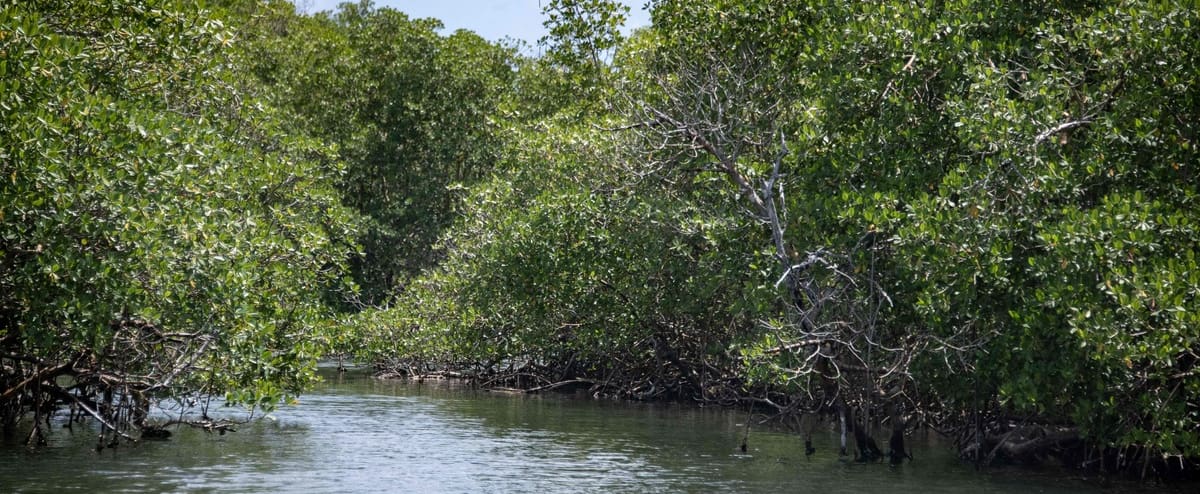Long neglected, the mangroves of the French island of Guadeloupe are slowly returning to the center of the debate thanks to the mobilization of nature defenders but also an awareness of the population and the authorities, who realize their essential role in the face of climate change and the loss of biodiversity.
• Read also: Climate change: 90% of peach harvests decimated in Georgia
These natural areas that grow on the edge between the terrestrial and marine worlds play an essential role for the majority of other ecosystems. “Without mangroves, we don’t have corals and we don’t have seagrass beds, and vice versa. And it’s the same with the land part: mangroves also have links with rivers, ponds, “explains Angeline Lollia, member of the Tropical Wetlands Relay Pole of the International Union for the Conservation of Nature (IUCN) in Guadeloupe.
Photo: AFP
Yet all over the world, these areas, whose importance has been celebrated every year since 2015 on the occasion of International Mangrove Day on July 26, are among the most threatened. More than 35% disappeared in 20 years, said a report in 2019.
Guadeloupe, which includes the largest mangroves in the Lesser Antilles, is no exception to the rule. “We have about 3,000 hectares of mangroves”, some in national parks, therefore well preserved, but others nibbled away by urbanization, “even destroyed to build on them”, notes Ms. Lollia.
But the problem is not so much quantity as quality because “a degraded mangrove can no longer fulfill its functions properly”, she explains.

Photo: AFP
Nursery and barrier
The threats to mangroves are numerous and almost all human-related, with urbanization and agriculture.
Pollution is a great danger. The mangrove, with its dense vegetation and tangled roots that plunge into the sea, recovers a lot of waste. Plants, she adapts to them because she can decompose them, but “a mangrove cannot decompose a washing machine, a tire or a plastic bag”, explains Ms. Lollia.

Photo: AFP
In Guadeloupe, a cultural component has been added, according to her: various “myths and legends” inherited from ancestral beliefs have long assimilated it to an area that is not very frequentable or even dangerous, leading to it being abandoned or even destroyed to protect against it.
But since the early 2000s, this perception has been changing.
“The population has become aware of the importance of mangroves”, in particular of its “barrier role” in the face of cyclones, she explains.
But the mangrove is not just that. It provides many services: coastal protection against swell and erosion, water purification, nursery for fish, essential habitat for birds and crustaceans…
It will also make it possible to “cut down the floods”, which is “an incredible service (…) much more effective than a dyke”, underlines Médhy Broussillon, deputy overseas delegate of the Conservatoire du littoral.
Restoration
Like forests, mangroves have “this ability to store carbon”: “they capture our greenhouse gas emissions and ultimately allow us to mitigate the impact of climate change,” he adds.

Photo: AFP
Guadeloupe, like many islands, is also particularly vulnerable to the consequences of climate change, in particular the risk of submersion. The most populated part of its territory, around Pointe-à-Pitre, is less than 80 cm above the sea. “We expect submersion to be chronic and repeated there in 2030 and up to 180 days a year in 2060”, noted in 2022 Virginie Duvat, one of the authors of the IPCC.
Faced with these threats, initiatives are multiplying in an attempt to save or even rebuild Guadeloupe’s mangroves.
Emblematic example: the “Ja-Riv” initiative, contraction of “rivage” and Jarry, territory in the center of the island which has become the third largest industrial area in France to the detriment of the humid forest. Since 2016, its mission has been to recover the land occupied by factories to return them to nature. Four hectares of mangrove have already been restored.
“Faced with climate change, all solutions are good to take”, underlines Bruno de Gasquet, director of the car dealership “Cama Premium”, participating in the operation. And the mangrove “is one of the best”, he underlines.
